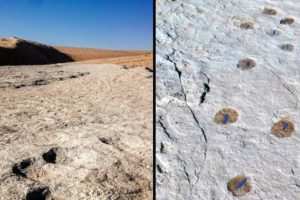
TALLAHASSEE, FLORIDA—Evidence suggesting that humans lived in northwestern Florida more than 14,000 years ago has been re-examined by an international team of scientists, who also conducted an additional excavation. In 1983,
stone artifacts and butchered mastodon remains were discovered at the Page-Ladson site, which is thought to have been a watering hole that is now located under 13 feet of sediment at the bottom of the Aucilla River. The sediments were dated to 14,400 years ago, but at the time, critics argued that the artifacts could have been carried to the site and deposited in the ancient sediments by river currents. The new excavation returned to the murky waters of the site and recovered more stone tools and the bones of extinct animals. “Artifacts are associated with the mastodon remains, including a tusk with tool marks. They were sealed in undisturbed geological deposits. Seventy-one new radiocarbon dates show the artifacts date to 14,500 years ago. The Page-Ladson site provides unequivocal evidence of human occupation that predates Clovis by over 1,500 years,” Michael Waters of Texas A&M University told Live Science. The new information also suggests that humans and megafauna coexisted for at least 2,000 years.















